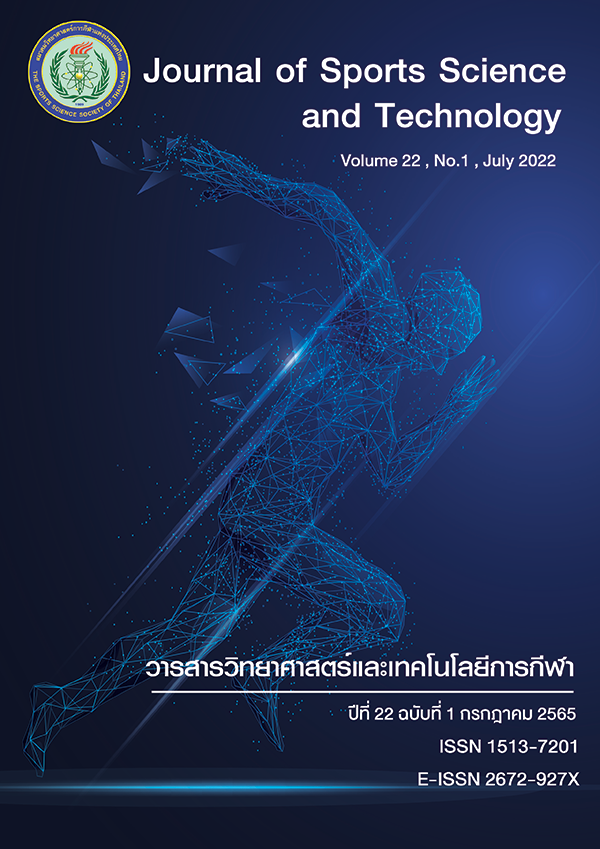PHYSIOTHERAPY PREFERENCE AND THE USE OF AMBULATORY DEVICES IN INDIVIDUALS WITH PARKINSON’S DISEASE
DOI:
https://doi.org/10.14456/jsst.2022.4Keywords:
Parkinson’s disease , Physiotherapy, Preference, Ambulatory DevicesAbstract
Objective: This study was aimed to survey the reason of physiotherapy (PT) preference and the using of ambulatory devices in individuals with Parkinson’s disease (PD). Methods: Sixty-nine individuals with PD with a variety of modified Hoehn and Yahr (H&Y) stages were recruited. Participants themselves answered open-ended questions including demographic data, PT preference, and walking status. A researcher examined the stage of PD in accordance with H&Y. The data were analysed in frequency. In addition, the association between PT preference and using ambulatory devices with the severity of PD were examined. Results: Forty-six percent of participants preferred PT, but fifty-four percent did not. The most motivation for PT preference was the advantage for health, whereas the non-PT-preference was the low expectations of PT outcomes. The Association between the using of ambulatory devices and severity of PD was found in moderate PD (χ2= 26.69, p<0.001). Conclusion: Most individuals with PD appeared not to have PT preference. The using of ambulatory devices were highlighted in individuals with PD in the moderate stage. However, the crucial concerning on the low expectations of PT outcomes were the most important point for consideration. The evidences from our study would emphasize on focusing the education of the PT benefit to individuals with PD and the using of ambulatory device in individuals with PD in the advanced stage. This might be the promising benefit on understanding role of PT on PD patients for improving their quality of life.
(Journal of Sports Science and Technology 2022; 22(1):(49-58)
(Received: 6 February 2022, Revised: 17 March 2022, Accepted: 7 April 2022)
KEYWORDS: Parkinson’s disease/ Physiotherapy/ Preference/Ambulatory Devices
*Corresponding author: Vimonwan HIENGKAEW
Faculty of Physical Therapy, Mahidol University
999 Phutthamonthon 4 Rd., Phutthamonthon, Salaya, Nakhon Pathom 73170, THAILAND.
Tel. +66(0) 2441-5450 ext. 21801
E-mail address: vimonwan.hie@mahidol.edu
References
Jankovic J, Tolosa E. Parkinson's disease and movement disorders. Philadelphia: Lippincott Williams & Wilkins; 2007.
Bloem BR, Grimbergen YA, Cramer M, Willemsen M, Zwinderman AH. Prospective assessment of falls in Parkinson's disease. J Neurol 2001; 248:950-958.https://doi.org/10.1007/s004150170047.
Bertrand K, Raymond MH, Miller WC, Martin Ginis KA, Demers L. Walking Aids for enabling activity and participation: A Systematic Review. Am J Phys Med Rehabil 2017; 96:894-903. https://doi.org/10.1097/phm.0000000000000836.
Moore G, Durstine JL, Painter P. ACSM's Exercise Management for Persons With Chronic Diseases and Disabilities 4th Edition: Human Kinetics, Inc.; 2016.
Radder DLM, Lígia Silva de Lima A, Domingos J, Keus SHJ, van Nimwegen M, Bloem BR, et al. Physiotherapy in Parkinson’s Disease: A meta-analysis of present treatment modalities. Neurorehabil Neural Repair 2020; 34:871-880.https://doi.org/10.1177/1545968320952799.
Rawson KS, McNeely ME, Duncan RP, Pickett KA, Perlmutter JS, Earhart GM. Exercise and Parkinson Disease: Comparing tango, treadmill, and stretching. J Neurol Phys Ther 2019; 43:26-32. https://doi.org/10.1097/NPT.0000000000000245.
Tomlinson CL, Patel S, Meek C, Herd CP, Clarke CE, Stowe R, et al. Physiotherapy intervention in Parkinson’s disease: systematic review and meta-analysis. BMJ 2012; 345:e5004. https://doi.org/10.1136/bmj.e5004.
Constantinescu R, Leonard C, Deeley C, Kurlan R. Assistive devices for gait in Parkinson's disease. Parkinsonism Relat Disord 2007; 13:133-138.https://doi.org/10.1016/j.parkreldis.2006.05.034.
Petzinger GM, Fisher BE, McEwen S, Beeler JA, Walsh JP, Jakowec MW. Exercise-enhanced neuroplasticity targeting motor and cognitive circuitry in Parkinson's disease. Lancet Neurol 2013; 12:716-726. https://doi.org/10.1016/S1474-4422(13)70123-6.
Abbruzzese G, Marchese R, Avanzino L, Pelosin E. Rehabilitation for Parkinson's disease: Current outlook and future challenges. Parkinsonism Relat Disord 2016; 22 Suppl 1:S60-64. https://doi.org/10.1016/j.parkreldis.2015.09.005.
Canning CG, Sherrington C, Lord SR, Fung VS, Close JC, Latt MD, et al. Exercise therapy for prevention of falls in people with Parkinson's disease: a protocol for a randomised controlled trial and economic evaluation. BMC Neurol 2009; 9:1-4. https://doi.org/10.1186/1471-2377-9-4.
Keus SHJ, Bloem BR, Hendriks EJ, Bredero-Cohen AB, Munneke M. Evidence-based analysis of physical therapy in Parkinson's disease with recommendations for practice and research. Mov Disord. 2007; 22:451-460. https://doi.org/10.1002/mds.21244.
Domingos J, Coelho M, Ferreira JJ. Referral to rehabilitation in Parkinson's disease: who, when and to what end? Arq Neuropsiquiatr 2013; 71:967-972.https://doi.org/10.1590/0004-282X20130209.
Nijkrake MJ, Keus SHJ, Oostendorp RA, Overeem S, Mulleners W, Bloem BR, et al. Allied health care in Parkinson's disease: referral, consultation, and professional expertise. Mov Disord 2009; 24:282-286. https://doi.org/10.1002/mds.22377.
Goetz CG, Poewe W, Rascol O, Sampaio C, Stebbins GT, Counsell C, et al. Movement disorder society task force report on the Hoehn and Yahr staging scale: status and recommendations. Mov Disord 2004; 19:1020-1028. https://doi.org/10.1002/mds.20213.
Health. DoHMoP. Manual for global physical activity surveillance among general population in province by cross-sectional [Internet]. Nonthaburi: Department of Health Ministry of Public Health; 2009 [cited 2014 August 8] Available from: http://203157740/exercise/tiki- download_filephp?fileId=20 (In Thai).
Keus SHJ MM, Graziano M, et al. European Physiotherapy Guideline for Parkinson's disease. KNPG/ParkinsonNet, the Netherland 2014:1-191.
Tomlinson CL, Herd CP, Clarke CE, Meek C, Patel S, Stowe R, et al. Physiotherapy for Parkinson's disease: a comparison of techniques. Cochrane Database Systematic Rev 2014:1-121. https://10.1002/14651858.CD002815.pub2.
Morris ME. Movement disorders in people with Parkinson disease: a model for physical therapy. Phys Ther 2000; 80:578-597.
Ellis T, Boudreau JK, DeAngelis TR, Brown LE, Cavanaugh JT, Earhart GM, et al. Barriers to exercise in people with Parkinson disease. Phys Ther 2013; 93:628-36.https://doi.org/10.2522/ptj.20120279.
Koerts J, Van Beilen M, Tucha O, Leenders KL, Brouwer WH. Executive functioning in daily life in Parkinson's disease: initiative, planning and multi-task performance. PloS One 2011; 6:e29254. https://doi.org/10.1371/journal.pone.0029254.
Schutzer KA, Graves B. Barriers and motivations to exercise in older adults. Prev Med 2004; 39:1056-1061. https://doi.org/10.1016/j.ypmed.2004.04.003.
di Biase L, Di Santo A, Caminiti ML, De Liso A, Shah SA, Ricci L, et al. Gait analysis in Parkinson's Disease: An overview of the most accurate markers for diagnosis and symptoms monitoring. Sensors (Basel) 2020; 20:3529. https://doi.org/10.3390/s20123529.






